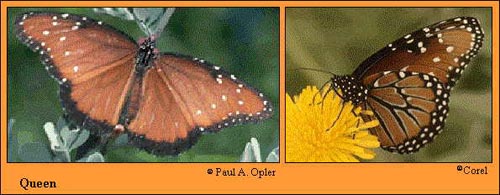Queen (Danaus gilippus)

Identification: Upperside is chestnut brown; black borders have 2 rows of white spots; white spots are scattered at the apex. Underside of hindwing has black veins; black border has 2 rows of white spots. Upperside of male hindwing has a black scale patch.
Life history: To find females, males patrol all day. Females lay eggs singly on leaves, stems, and flower buds; which the caterpillars eat. Adults roost communally.
Flight: All year in Florida and South Texas, July-August in the north.
Caterpillar hosts: Milkweeds and milkweed vines. Some of the milkweeds contain cardiac glycosides which are stored in the bodies of both the caterpillar and adult. These poisons are distasteful and emetic to birds and other vertebrate predators. After tasting a Queen, a predator might associate the bright warning colors of the adult or caterpillar with an unpleasant meal, and avoid Queens in the future.
Adult food: Nectar from flowers including milkweeds, fogfruit, and shepherd's needle.
Habitat: Open, sunny areas including fields, deserts, roadsides, pastures, dunes, washes, and waterways.
Range: Resident in extreme southern United States south through tropical lowlands of the West Indies and Central America to Argentina. Regular stray and sometime colonist in the plains; rarely along Atlantic coastal plain to Massachusetts and the Great Plains.
Conservation: Not usually required.
Management needs: None reported.
The Nature Conservancy Global Rank: G5 - Demonstrably secure globally, though it may be quite rare in parts of its range, especially at the periphery.